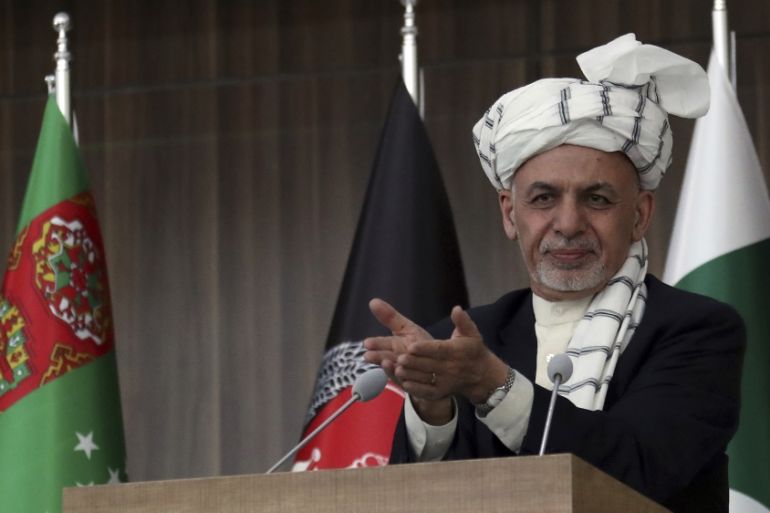What is behind the Eid ceasefire with the Taliban?
The crisis in Afghanistan is deepening and President Ashraf Ghani needs to engage the Taliban.

For the first time ever, the Taliban has announced a three-day ceasefire with the Afghan government over the Eid holiday period. They have ordered their forces to cease operations although they said they would continue attacking US forces in Afghanistan.
The Taliban’s move follows Afghan President Ashraf Ghani‘s earlier demand from the Taliban to respect a brief unilateral ceasefire which the government would enforce over the Eid holiday period.
Keep reading
list of 4 itemsPhotos: Tourist numbers up in post-war Afghanistan
Taliban ban on girls’ education defies both worldly and religious logic
Afghanistan calls for ‘respect’ after Cricket Australia snub
There have been many offers of temporary ceasefires by the government over the past two decades but none have yielded a positive response from the Taliban. It was thought that the Taliban had become too fragmented and, at the same time, too confident that they are winning the war to accept a ceasefire.
It appears that pressure from Pakistan on the Taliban Shura which largely resides in the Pakistani border town of Quetta has been instrumental in pushing the Taliban to agree to a ceasefire.
According to Lisa Curtis, deputy assistant to US President Donald Trump, Washington has been pursuing “multiple lines of effort” for bringing peace to Afghanistan and an important component of that effort was to ensure that Pakistan played “a constructive role” in it. US and NATO troops in Afghanistan will also observe this truce.
The strategy behind the ceasefire offer is to create a pause in hostilities for a few days which could be extended further. The end game of the Ghani administration is to jumpstart military and political dialogue aimed at ending the war.
Is the ceasefire a sign that the Taliban will enter into talks?
On February 28, Ghani issued a renewed call for the Taliban to join peace talks, promising that the government would recognise the group and give their leaders an office in Kabul. The Taliban never bothered to even reply to the offer.
At end of March, the Taliban were asked to attend a regional conference in Tashkent to discuss peace talks. They failed to turn up or even reply to Uzbekistan’s offer.
The Taliban’s main demand is to hold direct talks with the US – something they have been asking for over several years. They will not talk to the Ghani government which they consider to be a “puppet” of the US. And as far as the Taliban are concerned, it is the Americans who have to make the first concessions.
However, the possibility for direct talks happening is slim because there is disarray within all parties to the war. The Taliban are divided with individual commanders now asserting more authority in the field than the Quetta-based leadership.
In fact, even ensuring the ceasefire will be a big challenge for the Taliban leadership; it is doubtful that they have had the opportunity to consult all their field commanders. Instead, it seems that the Quetta Shura has taken a unilateral decision to accept the ceasefire.
Furthermore, the Taliban are on the offensive and most attacks across the country are initiated by them rather than the Afghan army. There is no reason for them to give up that advantage now.
Equally fraught is the regional balance of power. Pakistan, Iran, Russia and possibly other states are giving public support to the Kabul government but covertly engaging elements of the Taliban who operate close to their borders.
The Trump administration is also divided between remaining in Afghanistan until the Taliban are defeated (which could take years) or pulling out quickly. Before the US elections, Trump made it clear that he was in the leave camp, but it seems that he was subsequently persuaded by the US military to stay put in Afghanistan.
Why is Ghani insisting on a ceasefire now?
The crisis in Afghanistan is getting worse by the hour as the fighting intensifies and the government loses control of more districts.
It has been estimated that close to 200 soldiers and police officers were killed every week last year. The Afghan government cannot afford politically to continue having such a high death toll. The strength of the Afghan security forces has declined over the past 12 months, a US government watchdog has said. The number of security forces personnel has fallen by about six percent to just over 300,000, according to a new report.
The lack of safety is affecting severely the civilian population. UNICEF has reported that for the first time since 2002, it has registered an increase in out-of-school children. According to its report, some 3.7 million children between the ages of seven and 17 years (44 percent) are out of school due to the war.
Afghan’s are also increasingly facing food insecurity as this year’s draught has affected some 20 provinces. In its report, the United Nations Office for the Coordination of Humanitarian Assistance (UNOCHA) said that “this drought will have a particularly detrimental effect on already chronically food insecure farming households.”
Meanwhile, Afghanistan’s refugee problem is growing. Afghans continue to leave their homes to seek safety in other parts of Afghanistan or escape into neighbouring Iran or Pakistan or even further into Europe
As these multiple crises are worsening, Ghani is desperate to stop the fighting even for a day if it can give some respite to his people. A major diplomatic push is now needed in the region to make the ceasefire last longer than three days.
The views expressed in this article are the author’s own and do not necessarily reflect Al Jazeera’s editorial stance.
